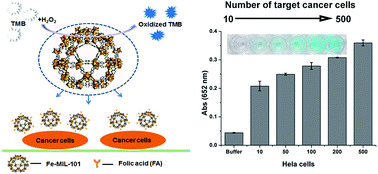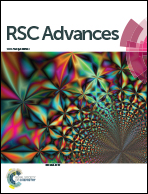Highly efficient colorimetric detection of cancer cells utilizing Fe-MIL-101 with intrinsic peroxidase-like catalytic activity over a broad pH range†
Abstract
Early diagnosis and the timely treatment of cancer are key to improving patient survival rates at present. Metal–organic frameworks (MOFs) consisting of infinite crystalline lattices with metal clusters and organic linkers may provide opportunities for the detection of cancer cells which have remained undiagnosed. Herein, we report that Fe-MIL-101 possesses an intrinsic enzyme mimicking activity similar to that found in natural horseradish peroxidase and shows highly catalytic activity even at neutral pH. The Michaelis constant (Km) of Fe-MIL-101 with H2O2 as the substrate is about 616-fold (at pH 4.0) and 20-fold (at pH 7.0) smaller than free natural horseradish peroxidase (HRP), indicating a much higher affinity for H2O2 than HRP and most of the peroxidase mimetics. Moreover, Fe-MIL-101 was successfully used to detect cancer cells by conjugating folic acid onto Fe-MIL-101 without any surface modification. The detection limit of the method for HeLa cells was estimated to be 50 cells and the reaction colour produced with 10 cells could also be observed by the naked eye. The proposed method holds considerable potential for simple, sensitive, universal, and specific cancer cell detection.


 Please wait while we load your content...
Please wait while we load your content...